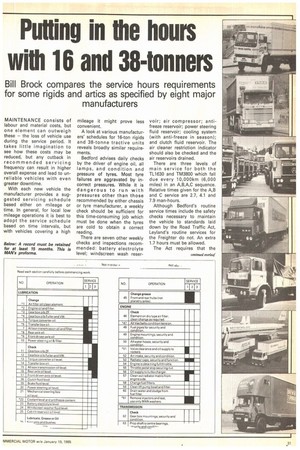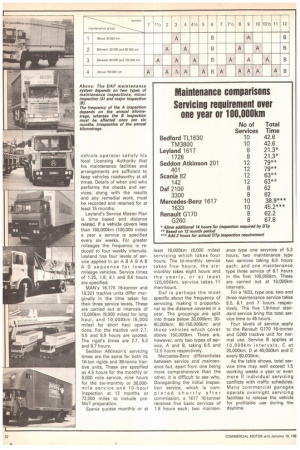Pulling in the hours with 16 and 38-tonners
Page 33

Page 34

If you've noticed an error in this article please click here to report it so we can fix it.
Bill Brock compares the service hours requirements for some rigids and artics as specified by eight major manufacturers
MAINTENANCE consists of labour and material costs, but one element can outweigh these — the loss of vehicle use during the service period. It takes little imagination to see how these costs may be reduced, but any cutback in recommended servicing frequency can result in higher overall expense and lead to unreliable vehicles with even greater downtime.
With each new vehicle the manufacturer provides a suggested servicing schedule based either on mileage or time. In general, for local low mileage operations it is best to adopt the service schedule based on time intervals, but with vehicles covering a high mileage it might prove less convenient.
A look at various manufacturers' schedules for 16-ton rigids and 38-tonne tractive units reveals broadly similar requirements.
Bedford advises daily checks by the driver of engine oil, all lamps, and condition and pressure of tyres. Most tyre failures are aggravated by incorrect pressures. While it is dangerous to run with pressures other than those recommended by either chassis or tyre manufacturer, a weekly check should be sufficient for this time-consuming job which must be done when the tyres are cold to obtain a correct reading.
There are seven other weekly checks and inspections recommended: battery electrolyte level; windscreen wash reser
voir; air compressor; antifreeze reservoir; power steering fluid reservoir; cooling system (with anti-freeze in season); and clutch fluid reservoir. The air cleaner restriction indicator should also be checked and the air reservoirs drained.
There are three levels of main service for both the TL1630 and TM3800 which fall due every 10,000km (6,000 miles) in an A,B,A,C sequence. Relative times given for the A,B and C service are 2.7, 4.1 and 7.9 man-hours.
Although Bedford's routine service times include the safety checks necessary to maintain the vehicle to standards laid down by the Road Traffic Act, Leyland's routine services for the Freighter do not. An extra 1.7 hours must be allowed.
The Act requires that the vehicle operator satisfy his local Licensing Authority that his maintenance facilities and arrangements are sufficient to keep vehicles roadworthy at all times. Details of when and who performs the checks and services, along with the results and any remedial work, must be recorded and retained for at least 15 months.
Leyland's Service Master Plan is time based and distance related. If a vehicle covers less than 160,000km (100,000 miles) a year a service is specified every six weeks. For greater mileages the frequency is reduced to four weekly intervals. Leyland has four levels of service applied in an ABABAB A D sequence for lower mileage vehicles. Service times of 1.25, 1.8, 4.1 and 8.6 hours are specified.
MAN's 16.170 16-tonner and 16.321 tractive units differ marginally in the time taken for their three service levels. These are carried out at intervals of 15,000km (9,000 miles) for long haul, and 10,000km (6,000 miles) for short haul operations. For the tractive unit 2.7, 5.5 and 8.9 hours are quoted. The rigid's times are 2.7, 5.3 and 8.7 hours.
Seddon Atkinson's servicing times are the same for both its 16-ton rigids and 38-tonne tractive units. These are specified as 4.5 hours for the monthly or 6,000 mile service, nine hours for the six-monthly or 36,000mile service and 10-hour inspection at 12 months or 72,000 miles to include preMoT preparation.
Scania quotes monthly or at least 10,000km (6,000 miles) servicing which takes four hours. The bi-monthly service takes five hours, the sixmonthly takes eight hours and the yearly, or at least 120,000km, service takes 11 man-hours.
Daf is perhaps the most specific about the frequency of servicing, making it proportional to the distance covered in a year. The groupings are split into those below 30,000km; 3080,000km; 80-150,000km; and those vehicles which cover above 150,000km. There are, however, only two types of service, A and B, taking 6.5 and 12.5 hours respectively.
Mercedes-Benz differentiates between service and maintenance but, apart from one being more comprehensive than the other, it is difficult to see why. Disregarding the initial inspection service, which is completed shortly after commission, a 1617 16-tonner receives five basic services of 1.8 hours each; two mainten
ance type one services of 5.3 hours; two maintenance type two services taking 6.6 hours each; and one maintenance type three service of 6.1 hours in the first 100,000km. These are carried out at 10,000km intervals.
For a 1633, type one, two and three maintenance service takes 6.5, 8.1 and 7 hours respectively. The five 1.8-hour standard service bring the total service time to 45 hours.
Four levels of service apply to the Renault G170 16-tonner and G260 tractive unit for normal use. Service B applies at 10,000km intervals, C at 20,000km, D at 40,000km and E every 80,000km.
As the table shows, total service time may well exceed 1.5 working weeks a year or even more if individual servicing conflicts with traffic schedules. Many commercial garages operate overnight servicing facilities to release the vehicle for profitable use during the daytime.














































































